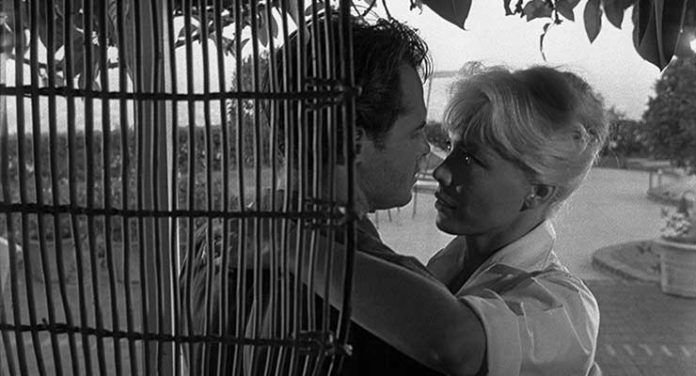Writer/director Leslie Stevens is best known as the creator of the 1960s sci-fi anthology series The Outer Limits, but in 1960 he directed this long-forgotten forgotten crime/drama noir Private Property. Starring Warren Oates in a breakout role that would help define the next couple of decades of his realist performances in the coming New American Cinema, and Leslie’s then wife Kate Manx in a role of seething sexuality as a neglected housewife. In a twist of sad irony, Manx would die only a few years later from suicide.
Perhaps it is easy to fall into the trap of looking at Private Property through modern eyes. On the surface the film seems quite subversive, with an undercurrent of repressed early 1960s sexuality and homoerotic nuance between the two male protagonists. Two violent drifters, Duke (Corey Allen) and Boots (Warren Oates), having just robbed a gas station, wander into the idyllic suburbs of Beverly Hills, where the two setup in an empty house across from a well-to-do married couple. Duke, after chastising Boots for never having had sexual relations with a woman, promises to seduce a woman and hand her over to Boots. Duke sets his sights on the flashy, sports-car driving blonde Ann Carlyle (Manx), who we quickly learn is quite neglected by her businessman husband who can barely muster up a “wife noises” to his associate while he’s on the phone as Ann lays out on the couch in an obviously amorous mood proclaiming she’s “ready to go to bed.” Duke is a charmer and when he shows up at Ann’s house claiming to be a gardener, she’s quickly ensnared by his seduction. Tension slowly mounts between Duke and Boots as Boots becomes convinced that Duke is going to keep Ann for himself and not “give” Ann to him.
The sexual dysfunction in Boots and Duke is perhaps the most obvious trap of modern thinking. Is it there, or is it a modern construct for us to infer some deeper meaning in Stevens’ work? As Duke sets up what we finally see is going to be a rape of Ann by Boots, something in itself a quite shocking topic for the era, there is obvious psychosexual tension at play between the two, especially when we see the final outcome of this slow-burning scenario.
The overall arc, however, could be even larger than this. Maybe it is an outright rejection of 1950s mores entirely. Remember, this is 1960; pretty much still tied to 1950s ideals. Ann is very much a 1950s housewife, at least as portrayed by the media. Her dissatisfaction is palpable and the destruction of the entire structure is the ultimate result of that dissatisfaction.
One thing is certain; Stevens coaxed magnificent performances out of the entire cast in this one, even given its almost bizarre theme. The mood is enhanced by the photography of Ted McCord who brings a stark, shadowy black and white film noir style to Leslie’s slow build up of tension that leads to an amazingly violent (for 1960) and chaotic climax in the final act.
[envira-album id=”94257″]
The Video
Private Property was restored by Cinelicious in 4K resolution on Cinelicious’ own Scanity film scanner from the earliest known existing element, a 35mm dupe negative that was recently discovered and preserved by the UCLA Film & Television Archive. The scan was then digitally restored frame-by-frame using a variety of tools to remove dirt, scratches, flicker and other damage. While the full aperture elements were completely restored, the film is presented in its original theatrical aspect ratio of 1.37:1.
I was invited to a screening of this new 4K restoration at Lincoln Center’s Elinor Bunin Munroe Film Center in New York City and at the time felt that the new 4K restoration looked breathtaking; like the film had hardly aged, that, in fact, it probably looked imagines almost as good as the day it first ran in theaters, with a beautiful, natural level of grain and wonderful black and white contrast.
This Blu-ray from Cinelicious Pics maintains most of the properties of what I saw back in June, perhaps even looking just a little bit crisper and grainier than I recall. The black and white contrast is still strong, with an mazing level of detail and nuance in the shadows and an absence of crush or clipping. The grain looks natural. The transfer comes in an AVC 1080p encodement at 24Hz.
The Audio
The monaural soundtrack is supplied in DTS-HD Master Audio 1.0 and it is a lot less boxy and dry than most monaural tracks, especially of this era. The dialogue and audio effects are clean and the balance of the music is good.
The Supplements
There isn’t much included here, but the essay and featurette with still photographer and technical consultant for Private Property Alexander Singer are musts.
- DVD – Feature film on DVD
- Interview with Alexander Singer (1.78:1; 1080p/24; 00:18:02) – The still photographer & technical consultant for Private Property gives a lengthy and informative interview about working on the film.
- Trailer (1.78:1; 1080p/24; 00:01:42)
- Essay “Ten Properties of Private Property” by Don Malcolm. This is a detailed look at the B-noir influences of Private Property, the production of the film, and the often tragic story of the actors who starred in it.
The Final Assessment
An unsettling early 1960s B-noir head-trip that was lost for many years and is now ripe for rediscovery by contemporary audiences, Private Property should be high on the list of cinephiles as a film worthy of reexamination and rewatching. The 4K restoration from Cinelicious Pics looks brilliant.
Editor’s Note: much of this review is reprinted from the review of Private Property’s 4K restoration theatrical run.
Be the first to leave a review.

